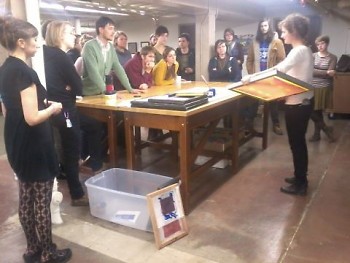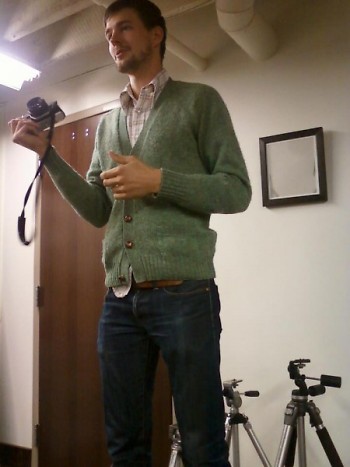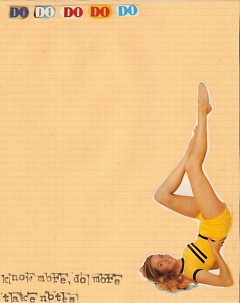I wasn’t sure what to expect from Sass Fest. It was promoted as "an event celebrating doing it together: music, workshops, movies, zines, handmade goods," a veritable bucket load of stuff proposed and organized predominantly by lady about town, Marlee Cook-Parrott. After perusing the event’s Tumblr blog, which was nicely conceived and clearly highlighted specific event times, I decided I would head down for the photography workshop at 3:30. I’ve been pretending for some time I might know something about photography and I hoped this talk could make that a reality.
Having attended other events on South Division and considering this was the first Sass Fest ever, I was impressed by the buzz coming from the venue at Calvin College's (106) Gallery (106 S. Division). The city’s trendiest if somewhat impractical bicycles leaned chained to the lampposts outside. The entrance was guarded by smokers with healthy vision, sporting peculiar spectacles: the surest signs that the bona fide creatives had arrived.
Upon entering the space I was faced immediately with tables and tables of excellent stuff. What surprised me the most about the handmade goods on offer here was the sheer quality. These weren’t the pressed flower coasters and dream catchers of my craft fair youth. There were no old ladies knitting repulsively abrasive pillows, nor did I spy any racks of horrible Christmas cards. This was a high class shopping experience if ever I saw one. It was full of stuff that you could legitimately wrap up for anyone and present as a unique item that is sturdy, usable, beautiful and morally viable, with everything from leather satchels and purses to jewelry, brooches and buttons. I have noticed the standards for craft here in America are on average far higher than my home country of Great Britain. You American fellows might be far more used to the quality than I am- but trust me - you’ve got it good.
The space was too small for the craft section of the occasion, adding a sense of intimacy that at times served to be warming and at others crowding. Once I had removed myself from the cluster and found the workshop basement, however, I had all the space I needed. John Hanson, an affable gentleman with an old cardigan and knack for explaining, presented a very engaging talk on the cameras he liked to use and why. I found out what an SLR camera is and at some point I will pass this information onto my mother (to whom I have been spinning an elaborate camera yarn that apparently bears no resemblance to the truth).
Whilst this talk was in progress, a workshop on screen printing went on behind me and in the next room Sara Bakker gave a sewing demonstration. I am positive these two workshops were as informative and useful as the one I was in. After speaking to Cook-Parrott about her vision for Sass Fest, I realized that her own focus was largely fixed onto the skills sharing and workshop portions of the event. She proposes that "learning from one another can be free." This is a wonderful sentiment, and I would argue that these information workshop and talk sessions were the most successful facets of the event. They were what distinguished Sass Fest as a forum for conversation and perhaps even an opportunity to further oneself.
It was impressive to see something like Sass Fest standing on its own two feet without the shelter of the umbrella provided by a larger organization. It was abundantly clear that the art community in Grand Rapids is thriving in terms of soul. This community is great enough in numbers now to make an event like this worth holding. The question of getting newcomers remains as tricky as ever, As a recent arrival myself I understand how daunting it can be to get the types who don’t necessarily ride a single speed bicycle, love felt, or make their own work -but who will appreciate the beauty and ingenuity of the wares on sale here- to take their first detour onto South Division Avenue.
Sass Fest 2011 had a short gestation but was definitely not as underdeveloped as I was expecting. Cook-Parrott admits herself that the event’s downfall was the lack of marketing: the outreach was confined mainly to friends and the usual social networking tactics. Even so, Sass Fest was a loveable triumph. A friend of mine suggested that this event should be a quarterly gathering. I supposed she is totally correct: as an annual event this could become too complex, too different from the original concept, and lose its charm; as a monthly event it would simply be too frequent. With a larger venue, someone to greet you at the door and a rotational set of similarly stellar speakers and workshops, Sass Fest will survive and thrive.
The Rapidian, a program of the 501(c)3 nonprofit Community Media Center, relies on the community’s support to help cover the cost of training reporters and publishing content.
We need your help.
If each of our readers and content creators who values this community platform help support its creation and maintenance, The Rapidian can continue to educate and facilitate a conversation around issues for years to come.
Please support The Rapidian and make a contribution today.



